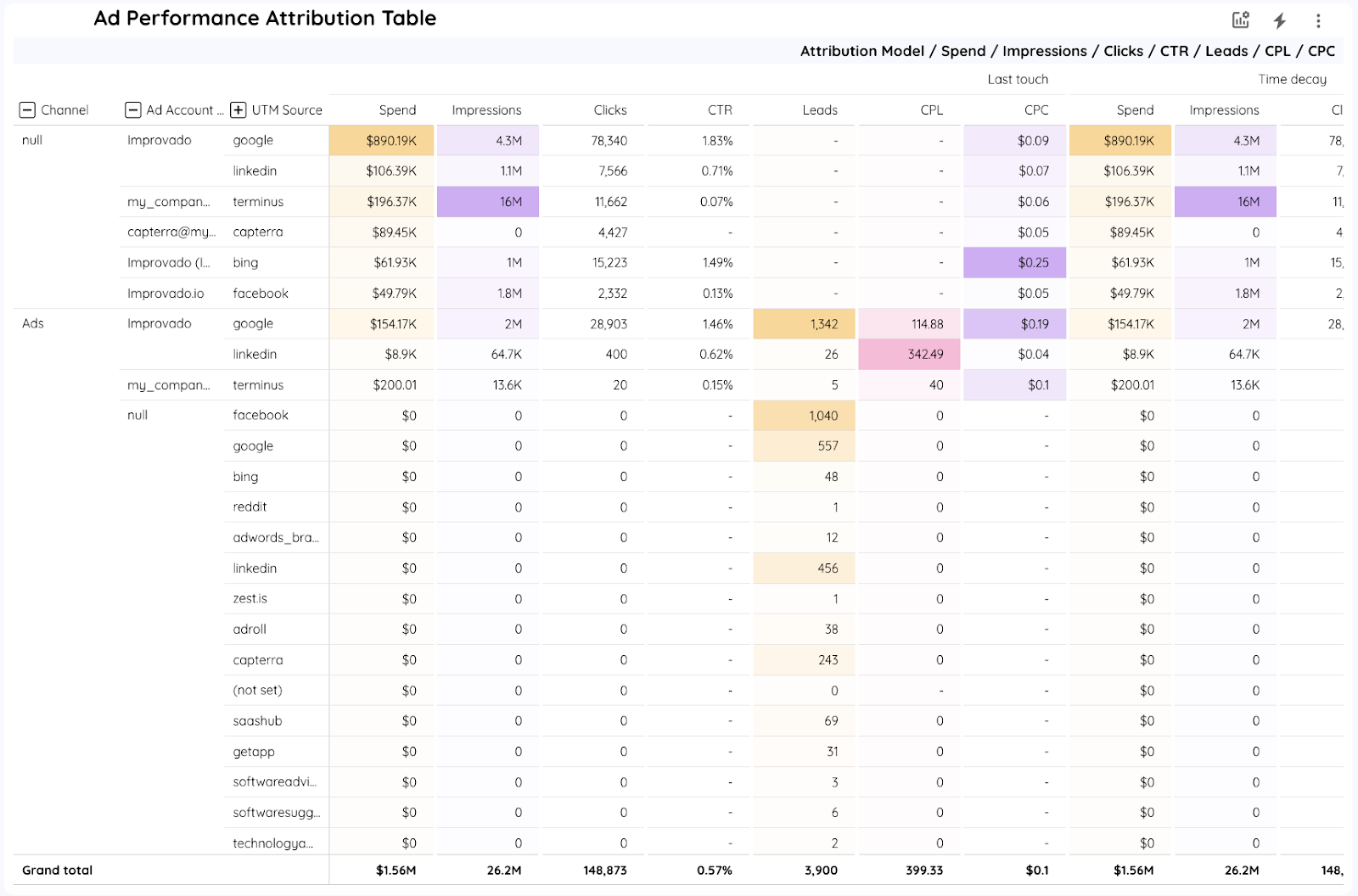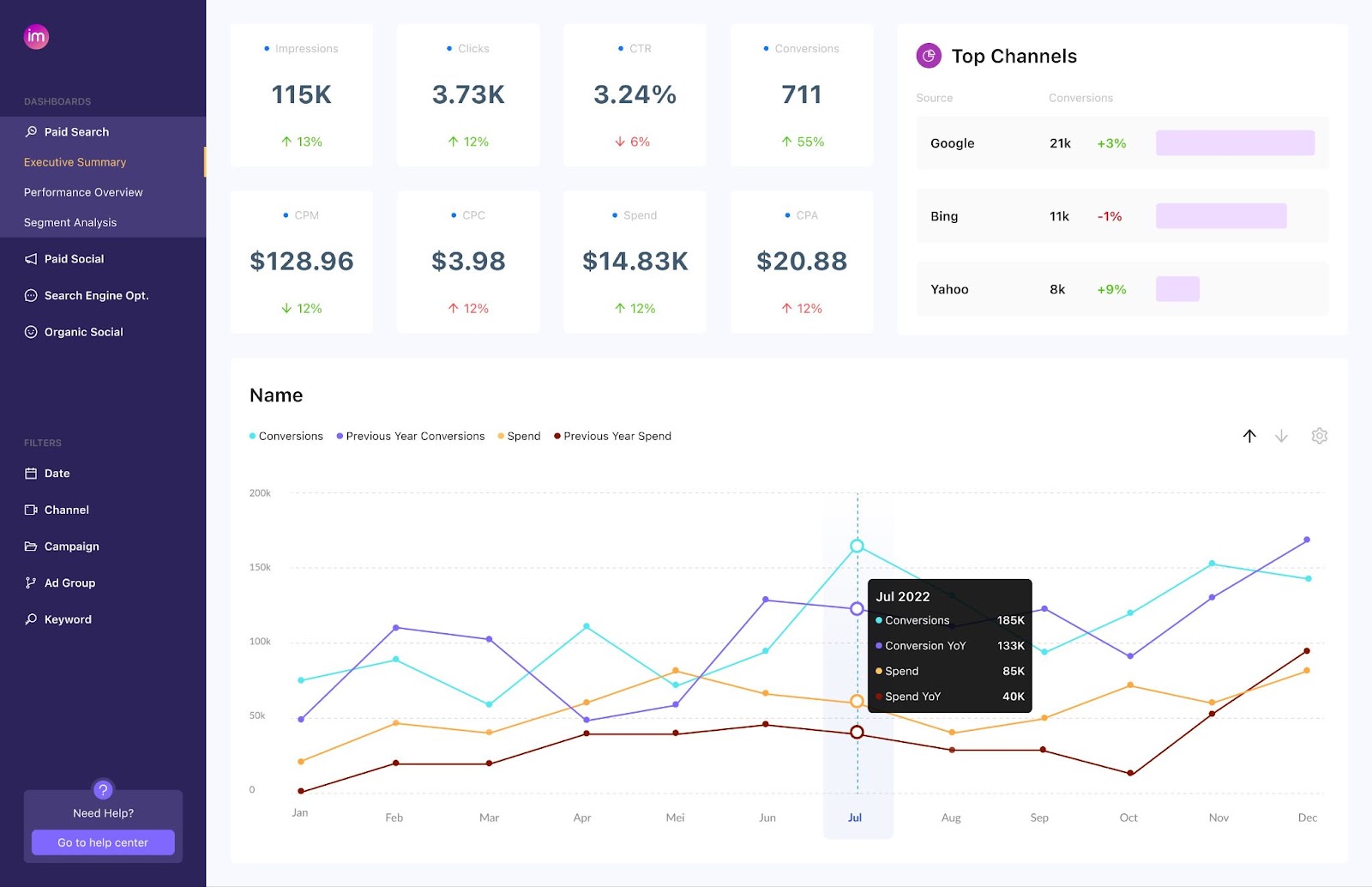Advertising analytics measures and analyzes ad campaign performance across platforms. It reveals trends, evaluates ad effectiveness, and helps optimize advertising strategies to engage audiences and drive business results.
Analyzing advertising data can feel overwhelming at first—but don't worry. This guide will break down basic and advanced advertising metrics, giving you analytics tools to confidently manage and improve your ad performance.
Let’s start from the essentials.
Five Fundamental Metrics of Advertising Analytics
These metrics are cornerstones for any ad campaign analysis. If you had to pick just five to focus on, these should be your go-to. Master them, and you’ll have a solid foundation for evaluating performance.
- Impressions: Counts how often your ad is displayed, regardless of user interaction. Helpful in gauging the overall reach of your campaign.
- Engagement Rate: Measures interactions such as likes, shares, and comments. High engagement often reflects strong audience connection and ad relevance.
- Click-Through Rate (CTR): Tracks the percentage of people who click on your ad after viewing it. A high CTR signals that your ad resonates with its audience.
- Conversion Rate: Measures the percentage of users who complete a desired action (e.g., making a purchase or signing up) after clicking the ad. Critical for assessing how well your marketing campaigns drive tangible outcomes.
- Return on Ad Spend (ROAS): Calculates the revenue earned for every dollar spent on advertising. It’s your go-to metric for evaluating campaign profitability.
Six Metrics Related to Different Advertising Models
To maximize budget efficiency and optimize campaigns, it’s crucial to understand the performance metrics associated with various advertising models. These models dictate how advertisers are charged—whether for views, clicks, or actions—and align with specific campaign goals like visibility, engagement, or conversions.
These six metrics help evaluate the effectiveness of these strategies:
- Cost Per Thousand Impressions (CPM): Calculates the cost of 1,000 ad impressions. It’s crucial for brand awareness campaigns as it provides insight into how efficiently your ads are displayed to your target audience.
- Cost Per Click (CPC): Tracks the cost of each click on your ad. CPC shows how much you spend to drive traffic and whether your campaign is cost-efficient.
- Cost Per View (CPV): Specific to video ads, it measures the cost for each view. CPV helps evaluate the efficiency of engaging users through video content and fine-tuning video ad budgets.
- Cost Per Engagement (CPE): Reflects the cost per interaction, such as a like, comment, or share. This metric is pivotal for engagement-focused campaigns, ensuring you’re driving meaningful interactions at a reasonable cost.
- Cost Per Lead (CPL): Tracks the cost of generating a qualified lead. It’s critical for lead-generation campaigns, as it helps determine if your advertising efforts are cost-effective and scalable.
- Cost Per Acquisition or Action (CPA): Measures the cost of acquiring a new customer. Essential for assessing the financial efficiency of direct response campaigns, ensuring customer acquisition remains profitable.
Four Advanced Metrics of Advertising Analytics
Advanced advertising metrics provide deeper insights into campaign performance and audience behavior. These metrics can help fine-tune strategies and maximize ROI:
- Lifetime Value (LTV): Measures the total revenue a business expects from a single customer over their lifetime. LTV is essential for evaluating the long-term profitability of customers acquired through advertising and helps determine how much you can afford to spend on acquisition.
- Share of Voice (SOV): Represents the percentage of your brand’s visibility in advertising channels compared to competitors. SOV is critical for assessing how well your brand captures audience attention in brand awareness campaigns.
- Page Views Per Visit: Indicates how engaging your website content is for visitors arriving through ads. A higher number of page views per visit suggests that your content resonates and encourages users to explore further.
- Attribution Window: Defines the timeframe in which a conversion is credited to an ad or campaign. Analyzing attribution windows helps accurately measure campaign impact and understand the customer journey across touchpoints.
Now that you know the metrics for measuring ad performance, let’s dive into the advertising analysis process and what it takes to execute it effectively.
Pro tactic for easier managing advertising metrics: Marketing Data Governance
Tracking a multitude of advertising metrics, managing their interdependencies, and reacting promptly to issues can feel overwhelming. However, there’s a smart solution that significantly reduces the workload and increases efficiency: it’s Marketing Data Governance.
With its help, you can set rules your campaigns must follow. For example, you can have a preflight checklist to automatically verify each campaign against a set of criteria before it goes live. Or, you want to make sure that your budget pacing is even throughout the campaign. Or, you want to keep your CPA under $15. Marketing Data Governance allows you to do all of that and more.
Once your campaigns are live, Marketing Data Governance monitors them in real time, alerting you promptly if anything goes off track. This proactive approach allows you to address issues immediately rather than after they've impacted your results.
What's more, it verifies the accuracy of all your data, providing reliable and ready-to-use information to power your dashboards, reports, and insights. This means you can trust the numbers you're seeing and make informed decisions without worrying about data discrepancies.
Advertising Analytics: Attribution, Optimization, and Allocation
Imagine you’re running a multi-channel ad campaign for a new product launch. You’re using search engine optimization and Google Ads to drive search traffic, Facebook Ads for retargeting, and Instagram for brand awareness. Sales are coming in, but when your boss asks which channel is driving the most value or whether you’re spending efficiently, you’re stumped.
This is where advertising analytics comes in. To truly understand and improve your campaigns, you need to master three core activities:
- Attribution—pinpointing which ads or marketing channels drive results.
- Optimization—refining your strategy for better performance.
- Allocation—distributing your budget to the right places.
Let’s break these down and explore how they can transform your campaigns.
1. Attribution
Attribution models help identify which touchpoints along the customer journey contribute most to conversions. By tracing a customer's steps—from initial awareness to purchase—you can determine which ads, channels, landing pages, and messages played key roles in influencing their decision-making.
Attribution isn’t just about measuring results—it’s about uncovering actionable insights to fine-tune your strategy and drive more significant impact.

Suppose a customer sees your display ad on Instagram, clicks a retargeting ad on Facebook, and finally converts after clicking a Google search ad. An attribution model can assign credit to each touchpoint based on its contribution. A last-click model might credit the Google ad entirely, while a multi-touch model would distribute credit across all three interactions, offering a clearer picture of what’s working.
Eight components of effective attribution modeling
For digital marketing teams aiming to implement effective attribution modeling, the following foundational elements are critical for success:
1. Unified tracking infrastructure is a system that collects and organizes data from all customer interactions in one place. It tracks every touchpoint—like clicks on ads, website visits, email opens, or even offline actions (if they can be linked digitally)—across all channels and platforms. Without centralized tracking, understanding the entire customer journey is impossible.
Retail brands often use a unified tracker to combine ads data from Google Ads, email campaigns, and in-store QR code scans, enabling a holistic view of customer interactions.
2. Raw data storage means having a centralized data warehouse for all gathered advertising and interaction data. It preserves historical data integrity, enabling deep analysis and flexibility to apply or refine attribution models as needed. Historical data lets you test multiple attribution models and refine strategies based on past performance.
3. Ad spend tracking accurately records and maps the money spent on advertising across various platforms. Since each ad platform has unique pricing and spend structures, tracking these details allows for precise ROI calculations.
Marketing teams often integrate ad spend data from platforms like Facebook, LinkedIn, and Google Ads into a single dashboard. This allows them to calculate ROAS for each channel, identifying which platforms drive the highest returns and where to allocate more of the budget. For instance, if Facebook shows a ROAS of 4:1 while LinkedIn only achieves 2:1, they can prioritize Facebook for similar campaigns.
4. Robust event streaming captures and processes customer interactions as they happen. This ensures up-to-date insights into campaign performance. Delayed data processing can lead to outdated decisions and missed optimization opportunities.
5. Custom conversion tracking that goes beyond sales or lead captures to include granular micro-conversions like sign-ups, downloads, or product demos. It provides a detailed view of how individual touchpoints contribute to the conversion funnel.
6. Custom event integration, such as product returns or service interactions, ensures your attribution model reflects the customer journey. It improves understanding of touchpoint contributions, even after a sale. Say a brand could integrate post-purchase surveys as custom events to link ad campaigns with customer satisfaction levels.
7. Flexible identity resolution tracks user interactions across devices, accounts, or household groupings. This ensures a unified customer view, regardless of where or how they engage. For example, telecom providers usually merge mobile app and desktop browsing data to understand customer intent across devices.
8. Advanced segmentation reveals which strategies and formats resonate most with specific audiences and demographics, driving better personalization and optimized ad targeting.
You can expect all the above-mentioned functionality from an Improvado-powered marketing attribution. Improvado streamlines attribution modeling for large enterprises by:
- Centralizing data from 500+ Ad, MarTech, and CRM platforms.
- Automating tracking of all touchpoints, ad spend, and events.
- Enabling flexible single- or multi-touch models.
- Providing data visualization and tailored dashboards to measure campaign impact.
Ready to see it in action? Get a demo with Improvado to unlock precise attribution and drive revenue growth.
2. Optimization
Optimization involves refining campaigns to improve performance by tweaking targeting, creative elements, or ad spend. This is an ongoing process that requires constant A/B testing and data analysis. Small adjustments in bidding strategy, messaging, or ad placement can yield significant ROI improvements.

How to set up real-time advertising monitoring and optimization
Effective optimization relies on timely insights. However, challenges like fragmented data across platforms, integrating offline and online interactions, and the complexity of measuring incremental reach often push marketers toward post-campaign analysis.
While valuable for future strategy, this approach delays action on live campaigns, leading to longer learning cycles and missed opportunities.
Improvado addresses these challenges by:
- Aggregating data across platforms: It consolidates data from fragmented advertising sources, including online and offline touchpoints, into a single dashboard.
- Providing real-time insights: Timely data updates allow marketers to adjust campaigns as they run, avoiding delays common with post-campaign analysis.
- Automating data preparation: It harmonizes inconsistent naming conventions and prepares data for analysis, saving hours of manual work.
3. Allocation
Budget allocation determines how to distribute advertising budgets across channels, campaigns, or audience segments to maximize returns. Proper allocation ensures that resources are focused on the most impactful areas.
For instance, a company running brand awareness campaigns sees that CPM is lower on LinkedIn than on Instagram, but engagement rates are significantly higher on Instagram. Based on this, they shift more of their budget to Instagram to boost reach and engagement.
Budget pacing is a critical part of allocation, which ensures the budget is spent evenly throughout a campaign. This avoids common pitfalls like overspending too quickly or leaving funds unspent while allowing real-time adjustments to stay aligned with both short-term objectives (like hitting weekly goals) and long-term marketing strategies.
You can choose between four approaches to budget pacing and allocation:
Manual tracking
How it works: Budget pacing and allocation are tracked manually, often through spreadsheets.
Best for: Small businesses or less complex campaigns where hands-on control is manageable.
Challenges:
- Time-intensive
- Prone to errors
- Less scalable for large or multi-platform campaigns
In-app tools
How it works: You’ll need to use platform-specific tools, like Google Ads’ Budget Pacing or Bing’s ad spend tools.
Best for: Businesses focusing on a single platform, where detailed native insights suffice.
Challenges: Limited scope—doesn’t provide a consolidated view across multiple platforms.
Automated tools
How it works: Third-party tools aggregate data across platforms, providing centralized pacing and allocation insights.
Best for: Medium-sized and enterprise businesses, agencies, or those managing campaigns on multiple platforms.
Benefits: Reduces manual work, improves efficiency, and enables cross-platform visibility.
AI-assisted tools
How it works: Advanced tools leverage AI to process large datasets and deliver instant insights for budget pacing and allocation.
Best for: Large companies and agencies running complex, high-volume campaigns.
Benefits: Offers real-time recommendations and predictive insights, making it easier to adjust budgets dynamically. This is especially useful during peak seasons or promotions.
How to Maximize ROI through Advanced Data Analytics
Maximizing ROI is all about spending smarter. Advanced ad analytics give you the insights to make data-driven decisions, optimize ad spend, and improve campaign performance.
On the flip side, managing multi-platform data, implementing real-time optimization, and leveraging advanced attribution models can feel overwhelming. Fortunately, tools like Improvado simplify the process. By consolidating data from various advertising platforms into a single, intuitive dashboard, Improvado empowers marketers to focus on actionable insights instead of data wrangling.
Don't let fragmented data hinder your KPIs. Take the next step—get a demo with Improvado and discover how advanced marketing analytics can revolutionize your strategies and boost your return on investment.
.png)




.png)
